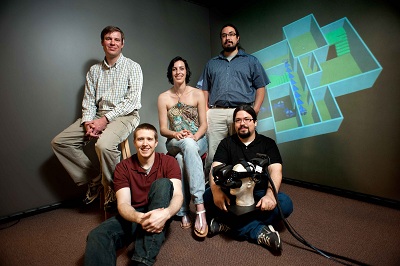ACADEMIA
Virginia Tech computer science students win international contest for third straight year
For the third consecutive year, a team of Virginia Tech doctoral students of the College of Engineering's Department of Computer Science and Center for Human-Computer Interaction has won first place in the 3D User Interfaces contest.
This year's competition required students to build a computer application that allowed two users to navigate through a complicated 3-D environment without any direct verbal communication. The Virginia Tech team, also the recipient of the "People's Choice" award as voted on by conference attendees, devised a virtual search and rescue scenario that required a rescuer to enter a burning building to look for survivors as a commander monitored progress on an interactive map of the structure.
During the scenario, the commander suggests various paths for the rescuer to follow in order to ensure the entire building is searched. At the same time, the rescuer places markers in the burning building to indicate where the survivors, blockages, hazards, and new openings are located.
The students produced a YouTube video of the application called CARNAGE: Collaborative Augmented Rescue Navigation and Guidance Escort.
They also authored a paper for the competition sponsored by the Computer Society of the Institute of Electrical and Electronics Engineers. In their paper, the students explained they chose this scenario because building disasters such as a fire require constant changes to path planning and cause difficult navigation in 3-D places. Responders in this type of scenario have great difficulty in navigation because of hazards, reduced visibility, disorientation, and lack of survey knowledge of the environment.
Since neither the commander nor the responder has complete information about the environment, effective communication is essential. By using CARNAGE, the commanders are able to work from the outside to help coordinate the rescue response.
According to the designers, the system helps pairs of users complete virtual search and rescue tasks with high rates of search coverage and virtual victims found. "The results suggest that the collaborative navigation system was effective for searching," said Doug Bowman, advisor to the team and associate professor of computer science .
Team members were Felipe Bacim of Porto Alegre, Brazil; Eric Ragan of Pittsburgh, Pa.; Siroberto Scerbo of Elizabeth City, N.C.; and Cheryl Stinson of Ottawa, Ontario, Canada.
This team beat out six other finalists from around the world, including a second team from Virginia Tech with Ph.D. students Panagiotis Apostelellis of Athens, Greece, and Bireswar Laha of Mumbai, India, participating. Other teams were from Belgium, France, Colombia, and Brazil. And, one team was comprised of members from both New Zealand and Massachusetts.
The competition was held in conjunction with the IEEE Symposium on 3D User Interfaces in Costa Mesa, Calif.

